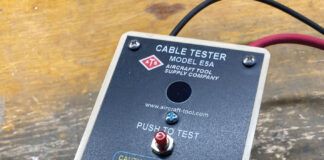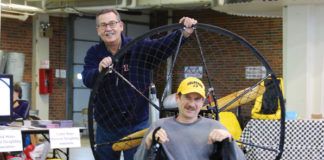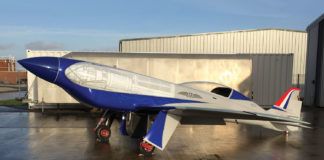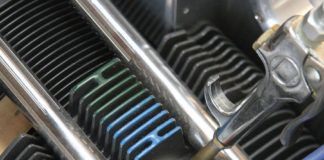Long ago, some wise homebuilder observed that, “Being 95% done means you still have halfway to go.” I used to think his remark was nothing more than a liberal dose of sour grapes flavored with a touch of humor, until my own project flew for the first time on November 10, 2006. After that 15-minute flight, where we confirmed that controlled flight was not only likely but also possible, my elation was surprisingly short-lived.
Readers of this series will recall that project leader Gus Warren had the honor of being N42KP’s first pilot. During our post-flight confab, he ran down the list of issues that needed correction, and my joy slowly drained away as I mentally tabulated how much more work was actually needed. There were quite a few things that required correction before this Corvair-powered Zodiac could continue Phase I flight testing, much less be ready to make the cross-country sojourn from the east coast of Florida to its (and my) home base in California.
Complicating matters even further was the start of the 10th Corvair College, beginning later that day and running through the weekend. This annual event would be followed by Warren’s departure to his native Michigan to assist his elderly parents with a move, and then everyone’s surrender to the holiday season (where normal people aren’t much bothered by such esoteric endeavors as airplane building for several weeks).
After comparing calendars and our individual upcoming time commitments, it became painfully obvious that I wasn’t going to be able to fly my own freshly built airplane until sometime in January 2007. Assuming, that is, that we could quickly correct a good number of the remaining squawks without too much difficulty during my remaining time in Florida. Suddenly, I understood the truth lurking behind the comment from that wise old homebuilder, and another lesson was learned.
No Shortage of “Challenges”
As a former electronic bench technician, I’m no stranger to the troubleshooting, fault identification and correction process. However, one of the overriding difficulties with a new airplane is tracking down issues in a vehicle where the systems may or may not have ever worked properly in the first place.
Even systems that appeared to be operating normally at first became suspect under a variety of ground and flight conditions. Of course, thorough debugging is one of the main goals of the initial FAA-mandated flight testing (called Phase I) that essentially says a new Experimental/Amateur-Built airplane needs to fly only in the local area for a minimum of 40 hours (assuming it has a non-certified engine and prop) with just the required crew before being turned loose on the rest of the world.
The problems could first be categorized by the component of the airplane to which the issue belonged (airframe, engine, instrumentation or avionics), and then by what kind of fault was being exhibited (totally inoperative, partially operational or suspected to be inaccurate). Add to that the reality of gray areas, where a suspected fault might well be caused by two or more of these categories. So, over the first few months of 2007, I made more trips to Florida to tackle what seemed to be a daunting list of problems as the Zodiac’s debut at Sun ’n Fun loomed ever larger on the horizon.
Airframe Issues
Other than the rudder’s vertical alignment problem that we discussed previously (that was primarily due to building the first fast-build 601 kit hatched by Zenith), there were few problems with the airframe or its supplied systems. But we did encounter some.
The Grove brakes howled and shuddered from day one. We figured the pads and disks just needed to bed in, but after several hours, the noise and vibration continued along with the marginal performance. The cause of the problem was ultimately traced to a bit of air in the brake lines, and a careful re-bleeding of each side cured it for good.
The dual sticks weren’t exactly centered in front of the seats, and the linkage between them seemed to be an inch or two short. Most people would probably not notice, but I have long legs and had installed Ray Allen grips that have a sizable flange at the bottom. With my usual bent-knee cockpit position, my right thigh was at precisely the correct height to intercept the grip’s flange during right turns, and impede full right aileron defection. Removing the offending grip and grinding off the flange on the right side cured the problem, and Zenith has most likely re-centered the dual stick option by now.
During high-speed (ha!) taxi tests, it seemed to me the elevator authority was a bit lacking. As soon as I had enough speed to raise the nose, the rest of the airplane wanted to levitate as well. The Zodiac wants to fly at relatively low airspeed (around 45 mph indicated at gross weight), so there isn’t much air flowing over the elevator in the flare during a full-stall landing. Later, during my first few trips around the pattern, holding the nosewheel off after the mains settled on the runway proved futile. Instead, the nosegear insisted on banging down immediately in spite of full-up elevator deflection.
The center of gravity was well within the recommended range, so we looked further and revisited our maingear installation. After a call to Zenith, we confirmed that the maingear assembly should’ve been mounted with the straight edge forward, bringing the axles an inch or so closer to the firewall. According to the factory, builders have the option to mount the maingear either way. Putting the axles further aft requires more down pressure from the elevator to pitch the nose up, of course. We should’ve stopped and thought about this instead of simply mirroring what was done on FlyCorvair’s own 601 XL taildragger.
We could’ve ordered a new maingear extrusion and remounted the brakes and axles, but the initial flight testing also confirmed that the electric trim spent its time between neutral and full nose up. After a call to the factory types for their opinion, we decided to raise the trailing edge of the horizontal stabilizer by 11 millimeters—or around 7/16 inch—by fabricating a pair of new mounting brackets, which gave the tail more low-speed authority and fixed the problem nicely.
Engine Issues
The good news is that there were few engine issues to deal with, because the assembly and testing of the converted Corvair motor were left entirely to the experts. As you may recall, I had initially planned to assist with the buildup of a suitable motor in concert with airframe construction, but later opted to just pay the freight for a completely assembled and pre-tested powerplant. This turned out to be one of the better decisions, as it greatly helped in troubleshooting the source of the discrepancies with the cockpit instrumentation.
By the time the airframe was ready for its engine, the Corvair had already been completely run in for 5 hours or so on the FlyCorvair test stand. When we got around to the initial flight testing, we already knew the engine had a short but solid history, and we also had accurate data on operating temperatures, oil pressure and power output. Knowing these parameters up front helped us zero in on the source of questionable engine monitor readings later.
One issue that stubbornly persisted throughout the project had been indications of slightly higher than desired oil temperatures. Not so much higher that a pilot would immediately start to look for suitable landing areas, but high enough over the duration of a long flight that an additional increase of 20° to 30° F might cause some concern. Oil does need to get up to at least 190° to expel the normal moisture that condenses into the sump, but many aircraft engines have their oil temperature redlines set at 240° or so. In our case, the oil temperatures on a balmy day seemed to settle in the 215° to 225° range.
One of the sources of these higher than desired indications was the placement of the oil temperature sender upstream of the massive oil cooler, effectively measuring the temperature of the heated oil as it left the engine before being cooled. Of course, moving the sender downstream of the oil cooler dropped the indication 10° or so, depending on ambient temperature. This didn’t change the actual temperature of the oil in the lubrication system, but it helped to lessen the constant consternation when scanning the oil temp indication.
Even though I’d ideally love to see the oil temperature hovering at about 195° to 200°, I have to remind myself occasionally that these tough little motors have run reliably for decades with nothing more than an oil pressure “idiot light” to alert the driver that something was amiss. Also, we’re not talking about a fast airplane here. With cruise speeds in the 100-knot neighborhood, there is a real limit to how much ram air is available through the nosebowl inlets to cool the engine when running in a high-power cruise setting, even though William Wynne and company have done a good job designing the baffling and oil cooler setup in the 601 to achieve maximum cooling efficiency.
Something Isn’t Right
My choice of the I-K Technologies AIM-Lite engine monitor system was based primarily on Ralph Krongold’s willingness to adapt his system to work with the Corvair engine. This combination hadn’t been tried before, so I knew that there might be some teething pains along the way. But our ace in the hole was Krongold’s dedication to the project, which we tested mightily.
Unlike conventional aircraft engines, the Corvair has a single cast head for each bank of three cylinders, so only two cylinder head temperature (CHT) probes would be needed. The exhaust header has an almost immediate radius upon exiting each cylinder, so six individual exhaust gas temperature (EGT) probes would be impractical. We decided on a single EGT probe for each three-cylinder bank. Monitoring only four temperature inputs instead of the usual 12 (for a typical six-cylinder aircraft engine) means that there are all sorts of surplus data channels available for monitoring other engine functions. With the Corvair, this particular I-K instrument was designed to monitor rpm, fuel pressure, oil pressure, oil temperature, and to scan back and forth between the left- and right-side CHTs and EGTs.
Upon putting the system to use, however, we noticed multiple discrepancies. The fuel pressure showed a little over a pound and a half, about 50% of what it should be. Oil pressure was also about half of what we saw on the test stand for the same engine. At cruise, the oil temperature quickly came up to the programmed red line of 240° and tripped the audible alarm. Worst of all, there was no tachometer indication. However, the CHTs and EGTs appeared to be right on the money.
Before the I-K engine monitor system was removed to be returned to Krongold for recalibration, I purchased and installed analog steam gauges from Mitchell, along with matching senders, to see if the I-K’s oil pressure and temperature indications were indeed inaccurate. A trip to a local speed shop in Daytona netted the plumbing and manual gauge needed to confirm the fuel pressure. A blade-counting TruTach was ordered to provide rpm information while the I-K was at the shop.
Ultimately, the problems with the pressure and temperature indications came down to relying on inaccurate data from the sender manufacturers for instrument calibration. Upon receiving the unit, Krongold took great care in recalibrating the system with the actual senders being used, which resolved these issues well. (We also used an MGL Avionics mini engine monitor for a short period; a review on that unit will appear in a future issue.)
The lack of tachometer indications was downright embarrassing. So many other parameters were suspect that we assumed the source of the fault had to be with the instrument. After substituting a couple of ignition lead senders for the flywheel tooth counter without success, and after a few sweaty hours with an oscilloscope and multimeter, I finally found the problem. We had wired the tach sender output to the wrong terminal on the I-K. Mea culpa, Ralph.
A Matter of Attitude
The Blue Mountain EFIS/Lite G4 system was designed as the ideal self-contained backup system, providing all of the traditional six-pack information as well as virtual HSI and even moving map with terrain. Given its small, square form factor, it seemed like the ideal instrument for my Zodiac. Upon installation, however, it presented its own interesting issues, some of which persist under certain circumstances.
According to the installation manual, the unit doesn’t require GPS satellite reception to provide solid attitude indications, but we found this not to be the case. During the first taxi tests, we found that acceleration and deceleration skewed the horizon badly, indicating either a climbing or descending turn when actually straight and level.
My first call to Blue Mountain’s technical support department about this issue went badly. The person who answered my phone call was rude and condescending, and chastised me for not having the latest software revision. The good news is that updating the unit’s software is a snap. Blue Mountain provides a USB thumb drive to capture the latest revision, and getting it into the G4 is as simple as plugging the drive into the front panel and turning the unit on.
Updating the software helped, but this issue wasn’t really addressed until the unit was left stationary outside of the hangar for 15 minutes to go through its initial GPS self-calibration cycle. Only after this did the attitude indications become usable in flight, despite what the manual claims. And yet, the horizon will still go awry occasionally during a steep spiral descent. As of this writing, I’m still not sure whether I have a defective unit, but more troubleshooting is needed to finally put this remaining issue to rest.
One-Man Firing Squad
Although it’s really tempting to blame others for the problems we encountered after the first flight, I have to admit that a good number of the causes rest squarely on my shoulders. I succumbed to the allure of the latest technology without giving it sufficient time to achieve maturity. Living on the leading edge can be fun, but it’s downright aggravating when it knocks you off of your build schedule.
I’m also guilty of letting a schedule interfere with measured, relaxed progress, as trying to get the Zodiac to the 2006 AirVenture resulted in less than ideal diligence when ordering the correct fuel gauges and double-checking system wiring performed in my absence.
There is a silver lining on the dark cloud of our less than ideal flight-test experiences, however. Should there be a second homebuilt in my future, I know for sure what aspects of the project will need extra care. I also learned that it’s entirely possible to shoot yourself in the foot when attention to detail is lacking.
As this is written, the Zodiac is on its way home from the east coast. Next month, I’ll wrap up this project with tales of the trip.




